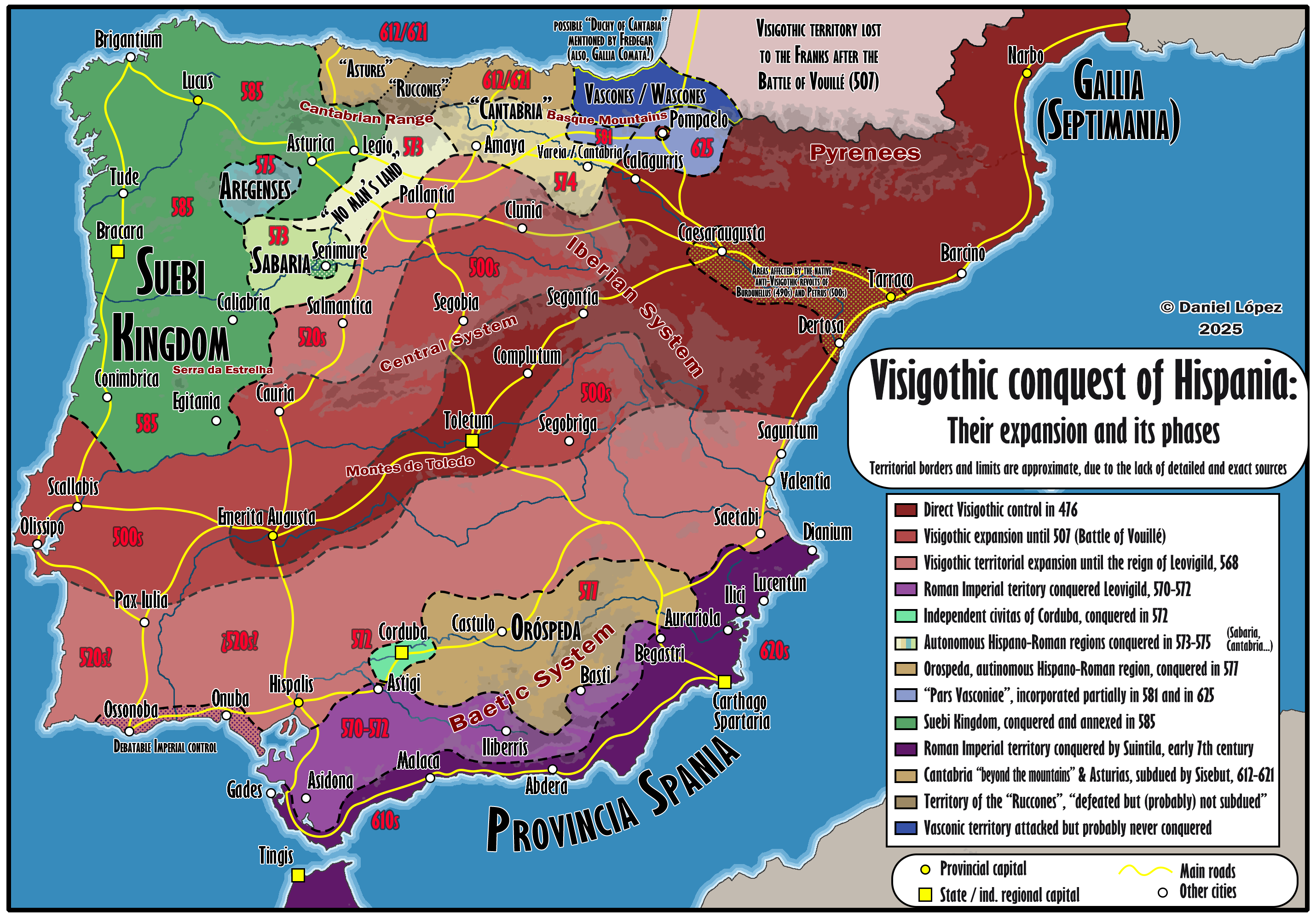Visigothic Conquest of Hispania Map


Marcus Rodriguez
Historical Geography Expert
Marcus Rodriguez specializes in historical cartography and geographic data analysis. With a background in both history and geography, he brings unique...
Geographic Analysis
What This Map Shows
This visualization illustrates the phases of the Visigothic conquest of Hispania, highlighting the territorial expansion of the Visigothic kingdom from the early 5th century to the early 8th century. With improved graphics and corrected inaccuracies, this map provides a clearer view of the regions affected by the Visigoths’ military campaigns and political maneuvers. By focusing on this significant historical event, we can better understand the territorial dynamics of early medieval Iberia.
Deep Dive into the Visigothic Conquest
The Visigoths were one of the prominent Germanic tribes that played a crucial role in the transformation of Europe during the decline of the Roman Empire. Their conquest of Hispania represents a pivotal moment in the region's history, marking the transition from Roman rule to the establishment of a new political order.
Initially, the Visigoths entered Hispania around 410 AD after sacking Rome. This act was not just a random raid; it was part of a larger migration pattern of various tribes moving into Roman territories. Interestingly, the Visigoths were initially settled in Aquitaine (modern-day France) but gradually moved southward, drawn by the region's resources and the waning power of the Roman Empire.
The conquest can be divided into several phases. The first phase involved establishing a foothold in southern Gaul and northern Hispania, where the Visigoths fought against both local Roman forces and rival tribes. By the mid-5th century, they had consolidated control over large parts of Hispania, including significant cities like Tarragona and Toledo. What's fascinating is that they didn't just conquer; they adopted many aspects of Roman culture, including their legal system and infrastructure, which facilitated their rule.
As the 6th century progressed, the Visigoths faced increasing challenges, both from within and outside their territories. Internal strife and succession crises weakened their grip, leading to fragmentation. The map illustrates how these internal conflicts influenced their territorial control, showing areas of fluctuating power and influence. The Visigoths had to contend with the Suebi in the northwest and the Byzantines in the southeast, which limited their expansion and control.
By the early 8th century, the Visigothic kingdom had reached its zenith, but it was also on the brink of collapse due to external pressures from the Muslim conquests. The Umayyad Caliphate invaded in 711 AD, marking the end of Visigothic rule and the beginning of a new era in the Iberian Peninsula. This transition is critical for understanding the cultural and political landscape of modern Spain and Portugal.
Regional Analysis
Looking at the map, we can break down the Visigothic conquest by region. The eastern and southern regions of Hispania, particularly areas like Catalonia and Andalusia, show early and significant Visigothic influence. For instance, the Visigoths established their capital in Toledo, which became a center of power and culture. Here, they managed to blend their traditions with the remnants of Roman civilization, creating a unique cultural identity.
In contrast, the northwest region, including Galicia, presented more resistance. The Suebi, another Germanic tribe, had already established a kingdom there, complicating the Visigothic expansion. This regional variation highlights the complexities of conquest and the importance of local power dynamics.
Moreover, the map reflects the geographical challenges the Visigoths faced. The mountainous terrains of the Pyrenees and the rugged landscapes of northern Hispania made military campaigns more difficult, impacting their ability to maintain control over these regions.
Significance and Impact
Understanding the Visigothic conquest of Hispania is essential not only for grasping the historical narrative of the Iberian Peninsula but also for comprehending the larger patterns of migration and cultural exchange that shaped Europe. The Visigoths' integration of Roman administrative practices laid the groundwork for future governance in Spain.
Additionally, the fall of the Visigothic kingdom to Muslim forces in the early 8th century initiated centuries of cultural and religious transformation, leading to the rich tapestry of influences that define Spain today. This transition also set the stage for the Reconquista, a pivotal historical period that would shape the identity of Spain for centuries to come.
In contemporary discussions, the legacy of the Visigothic period is often revisited in debates about national identity and cultural heritage in Spain. Understanding these phases of conquest allows us to appreciate the historical complexities that continue to influence modern Iberian societies. As we look forward, recognizing the historical significance of such events can help us navigate current cultural dialogues and regional identities within Spain and beyond.
Visualization Details
- Published
- September 23, 2025
- Views
- 74
Comments
Loading comments...